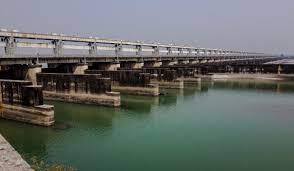The Farakka Barrage, located in the Indian state of West Bengal, is a major hydraulic engineering structure built across the Ganges River. Constructed with the primary objective of diverting water to the Bhagirathi-Hooghly River, the barrage has had a significant impact on the hydrology, environment, and socio-economic aspects of the region. However, it has also been the subject of controversy due to its consequences on river flow, sedimentation, and downstream ecosystems.

Historical Background: The idea of constructing a barrage at Farakka was conceived to address the issue of decreasing water flow in the Hooghly River, which affected Kolkata’s port and the surrounding areas. The project was initiated in the late 1960s and was completed in 1975, resulting in the creation of a 2,240-meter long barrage with various associated structures.
Water Diversion and Navigation: The primary function of the Farakka Barrage is to divert water from the Ganges to the Hooghly River to maintain navigability and provide a sufficient supply of freshwater to Kolkata. The barrage features navigational lock gates that allow vessels to pass through while regulating water flow. However, concerns have been raised about the efficiency of the barrage in maintaining navigability and sedimentation management.
Ecological Impact: The Farakka Barrage has had significant ecological consequences, particularly downstream of the barrage. Alterations in river flow patterns and sediment transport have affected the delta region, including the Sunderbans, a UNESCO World Heritage Site. The reduced freshwater flow and increased salinity levels have impacted aquatic ecosystems, including fish populations, and have led to changes in the morphology of the delta.
Sedimentation and River Morphology: One of the major challenges associated with the Farakka Barrage is the accumulation of sediment upstream, which affects the water-carrying capacity of the Ganges. The reduced sediment supply downstream has resulted in erosion and subsidence of riverbanks, impacting agriculture, riverbank communities, and infrastructure. The management of sedimentation and its impact on river morphology remains a subject of ongoing study and debate.
Interstate Disputes and International Relations: The Farakka Barrage has been a source of contention between India and Bangladesh. Concerns raised by Bangladesh include reduced freshwater flow in the Ganges, salinity intrusion, and adverse effects on agriculture and fisheries in the downstream areas. The issue has been addressed through various bilateral agreements and initiatives, but it remains a complex matter requiring continuous cooperation between the two countries.
Conclusion: The Farakka Barrage has played a significant role in regulating water flow and maintaining navigability in the Hooghly River. However, its construction and operation have resulted in a range of ecological, hydrological, and socio-economic impacts. Balancing the needs of navigation, water supply, and environmental sustainability requires ongoing monitoring, research, and collaborative efforts between stakeholders. The Farakka Barrage remains a subject of study, debate, and a case study for water resource management and transboundary river governance.
Note: This article provides a general overview of the Farakka Barrage and its impacts. For more detailed information, it is recommended to refer to academic papers, reports, and official documents on the subject.
Important Links